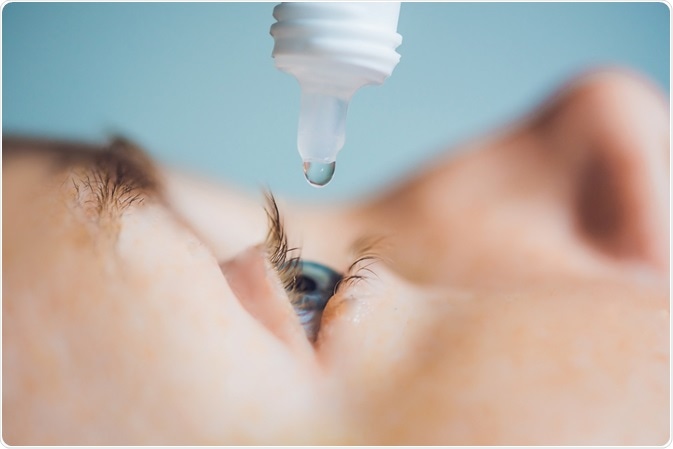Sjögren’s syndrome is a progressive, multisystem autoimmune disease characterized by sicca.
 Image Credit: Elizaveta Galitckaia / Shutterstock.com
Image Credit: Elizaveta Galitckaia / Shutterstock.com
What is Sjögren’s Syndrome?
With a typical age of onset between 40 and 60 years old, Sjögren’s (pronounced show-grins) syndrome is a progressive autoimmune disease affecting the areas of the body which synthesize fluids, including saliva and tears.
The hallmark features of the condition include sicca (dryness) which arises due to progressive damage of the exocrine glands, namely the lacrimal and salivary glands. Some patients with a more systematic phenotype develop manifestations involving the nervous system, musculoskeletal systems, kidneys, lungs and the skin and blood vessels.
Individuals can either develop primary Sjögren’s syndrome or the associated symptomology in addition to another autoimmune disorder, referred to as secondary Sjögren’s syndrome.
Symptomology for the syndrome can be differentiated into those associated with exocrine dysfunction (glandular) and those that affect everything else in the body aside from the exocrine glands (systemic). The most common symptoms include:
- Dry skin
- Fatigue
- Joint or muscle pain
- Skin rashes
- Dry mouth
- Dry eyes
- Swelling of the salivary glands
- Vaginal dryness
Adverse quality of life impairments is often associated with the condition, even in those without additional systematic presentations due to disabling fatigue which leads to impaired productivity.
Diagnosis of Sjogren’s Syndrome
A blood test can be administered in order to diagnose an individual with Sjögren’s syndrome. The blood test can help identify the presence of immunologic abnormalities, such as serum Sjögren’s syndrome-related antigens (anti-SSA antibodies). These antibodies attack healthy areas of the body, and if present, can be indicative of Sjögren’s syndrome.
However, some individuals with the condition will not present with anti-SSA antibodies. Therefore, other diagnostics methods need to be employed. An ophthalmologist might assess the eye to see whether a layer of tears produced in response to colored eye drops becomes patchy and inconsistent – one of the signs of Sjögren’s.
One of the primary diagnostic challenges for practitioners is a difficulty in differentiating the symptoms of the syndrome from other similarly presenting syndromes. For example, fatigue, dry eyes, and joint or muscle pain is also commonly seen in those with pain syndromes, including fibromyalgia. As Sjögren’s syndrome is relatively rare, misdiagnosis may occur.
Living With Sjogren's Syndrome: A Pediatric Patient's Journey
Treatment of Sjogren’s Syndrome
Currently, Sjögren’s syndrome is incurable. However, several treatments are available to help manage and alleviate some of the symptoms, mainly those associated with the sicca. Treatment is typically managed across a multidisciplinary team featuring a dentist, ophthalmologist, and rheumatologist, as a minimum.
Dry Eye Treatment
The treatment for dry eyes depends on the severity of the dryness, which is assessed based upon three features: eye surface alterations, tear composition and tear function.
Recommended preventative actions include, promoting good eye hygiene, the avoidance of medication that decreases the production of tears and environmental adjustments such as avoiding looking at television and computer screens for prolonged periods. In more severe cases, twice daily artificial eye drops are often prescribed.
Dry mouth Treatment
Saliva is responsible for lubricating the mouth and boasts antimicrobial and buffering properties. In those with Sjögren who have a dry mouth, issues relating to speaking, swallowing and chewing effectively can arise. Additionally, oral infections and disease can be more prevalent.
To minimize the likelihood of poor oral health, patients with Sjögren with mild inadequate saliva production are given sugar-free chewing gum to increase saliva or gels that act as saliva substitutes. Pilocarpine may also be prescribed, which treats both dry eyes and dry mouth by assisting the body to synthesize more tears and saliva.
Several other non-medical strategies can be used to help reduce the severity of symptoms. These include avoiding smoking, dry or windy places, cleaning the eye area regularly, and avoiding food and drink high in sugar.
Overview of Sjogren’s Syndrome
Complications of Sjogren’s Syndrome
Unfortunately, those with Sjögren’s syndrome are more at risk of developing certain health conditions compared to the rest of the population.
Cancer
Research has found that the likelihood of developing B-cell lymphoma is between 15 to 20 times greater in those with the syndrome compared to the general population. This particular risk is attributed to the chronic activation of B-cells in the syndrome.
The most prevalent types of lymphomas developed include low grade, marginal zone histologic B-cell non-Hodgkin’s lymphomas, which commonly occur in the salivary glands. Signs of the disease include unintentional weight loss, swollen glands in the groin, armpit or neck, and night sweats.
Vision Issues
Those with Sjögren’s syndrome who have untreated, dry eyes are more likely to incur damage to the outer layer of the eye, leading to irreversible vision issues. Having regular optician check-ups is essential to monitor and detect any problems early.
Lung Problems
Lung infections, bronchiectasis, and scarring of the lung tissues is a prevalent complication in individuals with Sjögren’s. Due to this increased risk, smoking is advised against to reduce the onset of such conditions and the aggravation of the lung tissue.
Pregnancy Complications
Although the majority of women with Sjogren’s syndrome can get pregnant and carry healthy babies, women are advised to speak to their doctor when planning to conceive due to potential complications. The main complications are heart issues in the baby and a rash that is present on the baby that lasts a few weeks postnatally.
Sjögren’s Syndrome - Treatment | Johns Hopkins
References and Further Reading
NHS (2020). Sjögren’s syndrome: overview. https://www.nhs.uk/conditions/sjogrens-syndrome/
Saraux, A., Pers, J. O., & Devauchelle-Pensec, V. (2016). Treatment of primary Sjögren syndrome. Nature Reviews Rheumatology, 12(8), 456. Doi: 10.1038/nrrheum.2016.100
Nocturne, G., & Mariette, X. (2015). Sjögren Syndrome‐associated lymphomas: an update on pathogenesis and management. British journal of haematology, 168(3), 317-327. Doi: 10.1111/bjh.13192
Mariette, X., & Criswell, L. A. (2018). Primary Sjögren’s syndrome. New England Journal of Medicine, 378(10), 931-939. Doi: 10.1056/NEJMcp1702514
Saraux, A., Pers, J. O., & Devauchelle-Pensec, V. (2016). Treatment of primary Sjögren syndrome. Nature Reviews Rheumatology, 12(8), 456. Doi: 10.1038/nrrheum.2016.100
Further Reading